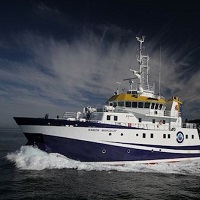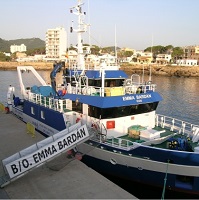Keyword
pH sensors
67 record(s)
Type of resources
Categories
Topics
INSPIRE themes
Keywords
Contact for the resource
Provided by
Years
Formats
Status
-

Spanish Porcupine bottom trawl survey aims to collect data on the distribution and relative abundance, and biological information of commercial fish in Porcupine bank area (ICES Division 7b-k). The primary target species are hake, monkfish, white anglerfish and megrim, which abundance indices are estimated by age, with abundance indices also estimated for Nephrops, four-spot megrim and blue whiting. Data collection is also collected for several other demersal fish species and invertebrates.
-

Spanish Porcupine bottom trawl survey aims to collect data on the distribution and relative abundance, and biological information of commercial fish in Porcupine bank area (ICES Division 7b-k). The primary target species are hake, monkfish, white anglerfish and megrim, which abundance indices are estimated by age, with abundance indices also estimated for Nephrops, four-spot megrim and blue whiting. Data collection is also collected for several other demersal fish species and invertebrates.
-

Get more information regarding the characteristics and distribution of benthic habitats present inside the Columbretes Islands Marine Reserve with the objective of Develop a bionomic map that covers the total extent. The complementary objective is the realization of the benthic cartography. It is intended to achieve location and subsequent georeferencing of the upwelling of gases present in the environment of the volcanic archipelago that forms The study area of this campaign. Associated with this objective is intended to know the Bacterial community in the area of gaseous upwellings and a physicochemical characterization of these areas.
-

Main targets: · ESTOC Observatory service - EMSO-ICOS. · ESTOC time-series - Winter sampling. · Coastal observatory sampling. · Time Serie for environmental control of the PLOCAN test bed.
-

Get more information regarding the characteristics and distribution of benthic habitats present inside the Columbretes Islands Marine Reserve with the objective of Develop a bionomic map that covers the total extent. The complementary objective is the realization of the benthic cartography. It is intended to achieve location and subsequent georeferencing of the upwelling of gases present in the environment of the volcanic archipelago that forms The study area of this campaign. Associated with this objective is intended to know the Bacterial community in the area of gaseous upwellings and a physicochemical characterization of these areas.
-

To collect relevant information to evaluate The levels of eutrophication in the coastal strip between Algeciras and Barcelona (Iberian coast, Alborán Sea and NW Mediterranean).
-

Main targets: · ESTOC Observatory service - FixO3. · ESTOC time-series - Winter sampling. · Coastal observatory sampling. · Time Serie for environmental control of the PLOCAN test bed.
-

The goals of this campaign are framed within the objectives of the overall project 'Radial Profunda de Canarias', being the experimental cruise of the proposal. Thus, this cruise will help to: • Determine the structure of the current when it reaches the Canary Islands, mass transport, heat and nutrients and interannual variability. • Characterize the different modes of variability of heat and mass transport in easternorth atlantic subtropical gyre. • To determine the correlation between heat and mass transport with the NAO atmospheric and oceanic index. • Characterize the annual cycle in the physical conditions of the surface layers and mixture to where the seasonal cycle is significant, relating it to the meteorological forcings. • Characterization of changes in water masses, mainly in the North Atlantic Central Water (NACW), in Antarctic Atlantic Intermediate Water (AAIW) in Mediterranean Water (MW) and bottom waters of the Canary Basin, in based on temperature, salinity, nutrients and oxygen.
-

Main targets: · ESTOC Observatory service - FixO3. · ESTOC time-series - Winter sampling. · Coastal observatory sampling. · Time Serie for environmental control of the PLOCAN test bed.
-

The main target of the "VULcanología CAnaria submariNA, VULCANA" project, is to study from a physicochemical, biological and geological point of view underwater volcanoes and hydrothermal systems active or not in the entire Canary basin. In addition, special attention will be given to the continuity of studies carried out in the Tagoro submarine volcano on the island of El Hierro, continuing like this, with one of the Longest physical-chemical-biological time series in the Spanish territory. The specific objectives of the Vulcana-III-0421 will be: 1.- Study of the temporal variability of physical, chemical and biogeochemical properties. a) Study of the temporal variability of temperature, salinity, pH-orp inside the crater the main submarine volcano Tagoro. b) Study of the spatio-temporal variability of thermohaline, fluorescence and oxygen fields dissolved in the hydrothermal plume of the Tagoro submarine volcano. c) Study of the spatio-temporal variability of the biogeochemical cycles of nutrients majority (nitrogen, phosphorus, silicon and ammonium). d) Evaluation of the anthropogenic influence through the analysis of marine microplastic in the water column 2.- Evaluation of the impact of the eruptive process on the microbial community. a) Study of the variability of the microbial community in relation to the emission of fluids hydrothermal by the Tagoro volcano. b) Study of the variability of microbial abundance in relation to the emission of fluids hydrothermal by the Tagoro volcano. c) Study of the variability of the chlorophyll concentration in relation to the emission of fluids hydrothermal by the Tagoro volcano. d) Study of the concentration and 12C / 13C isotopic ratio of CO2 and CH4 continuously dissolved in water surface and by discrete samples at different depths in the water column.
 Catálogo de datos del IEO
Catálogo de datos del IEO